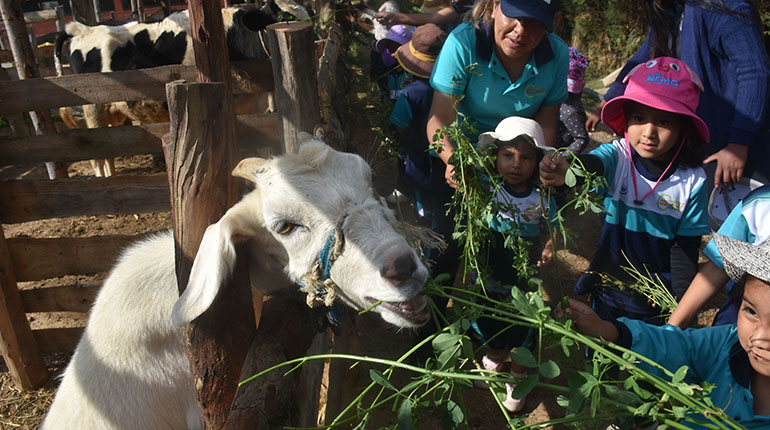Munay Education Farm, the Quechua name translating into Spanish for “want,” is a garden of fruit trees, ornamental plants, and vegetables that are home to an enormous variety of animals. This space for animals and plants is located in the Molocata region, just 10 minutes from the historic center of the municipality of Sacaba, in Cochabamba.
Orlando Alvarado, who started this educational project with his family five years ago, recalls that the idea was given to him by a relative who had come to visit him from Chile.
“It has been about 30 years of animal husbandry. I started raising pigs and then devoted myself to raising chickens. But since it was no longer a good business to have a small farm, I decided to close it, until my sister-in-law came from Chile and gave us the initiative to set up a teaching farm, similar to that Found in that Orlando said.
He said that at that time he decided with his daughters to open the educational center “which we call Monay, which in Spanish means I want”.
The entrepreneur recounted that he is a lover of plants and animals, and that this was one of his main motivations for starting the farm.
“I’ve always loved animals and plants, that’s why I’m always on the farm, although we also have staff to help us. But we work more like a family.”
Ximena Alvarado, the farm manager, emphasized that animals, just like humans, need a lot of love, affection and patience. In addition, he indicated that you should be responsible for the food.
A variety of animals
Among the animals that inhabit Monae’s farm are the Bushoni pigeon, which has a bulbous crop; Nasturtiums, which have a kind of hood on their heads; kolipavas, which have a tail similar to that of a turkey; And laughter. There are also peacocks, bow tie, cockatoos, partridges and other birds.
Also, this park is home to Castile rabbits and baby rabbits, the latter being distinguished by having lop-ears. As for the guinea pigs that are often confused with rabbits, the most striking ones are those with curly hair and those with long hair. In general, the latter is preferred for pets.
Among other animals, there are geese, among which you can see the African goose, which stands out most in its appearance. Likewise, you can see the red duck, the Polish, silky and Guinean hen or the African hen, which is the only one that flies.
On the other hand, the animals that are waiting to be fed by the visitors are the ostrich, hinnies (equine mammals born from the crossing of a horse and a donkey), goats, cows, sheep, horses, llamas and many other animals.
The farm also has a fingerling pond and two swimming pools with koi, mirror fish and other species.
Workshops
Apart from feeding and interacting with the animals, visitors participate in two workshops; That of the orchard and knead. In the beginning, you will learn about growing plants; And in the second, the origin of flour and eggs is known and ends up making cakes in the shape of animals.
In Munai, food is prepared for each animal.
Sacaba supports entrepreneurship
According to the Director of Human Development in the Sacaba Mayor’s Office, José Trujillo, all tourism and educational projects have the support of the municipality.
Vision
The vision of Monay Education Farm is to create a nursery and sell organic plants. Currently, they are making compost. Munay attends educational units and institutions from Monday to Friday, and on Saturdays and Sundays for the general public, in three times, at 10:00, 14:00 and 16:00. Entrance 20 boliviano.




![[Actualización] They promote environmental care through the eco-recreational space “La Ribereña” – El Sol de Tlaxcala [Actualización] They promote environmental care through the eco-recreational space “La Ribereña” – El Sol de Tlaxcala](https://www.elsoldetlaxcala.com.mx/local/6dni8n-riberena.jpg/ALTERNATES/LANDSCAPE_1140/Ribereña.jpg)
